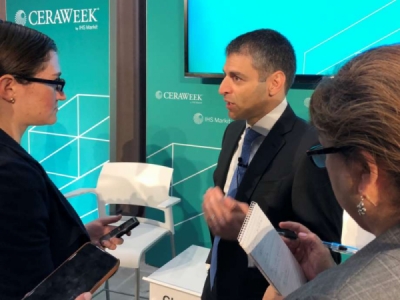
Posted on March 19, 2019
Carlyle Group Managing Director Ferris Hussein speaks with reporters at CERAWeek by IHS Markit. The Carlyle Group is investing $400 million into developing a crude oil export terminal near Corpus Christi.
A Washington investment firm is making a $400 million bet that will allow Corpus Christi to regain and keep its status as the top U.S. crude oil exporter.
The Port of Corpus Christi was the location of the first U.S. crude oil export in December 2015. The South Texas waterway remained the top U.S. crude oil export hub until last month, when recently completed pipeline projects allowed the Port of Houston to claim the title.
During a Tuesday morning panel discussion at CERAWeek by IHS
Markit, Carlyle Group Managing Director Ferris Hussein said the firm is investing $400 million into a project that will catch a wave of new Permian Basin to Gulf Coast crude oil pipelines that are expected to come into service over the next year and a half shifting exports back to Corpus Christi.
“Corpus Christi will surpass Houston as the export hub of the U.S.,” Hussein said.
Supersize Me: Moda Midstream has VLCC-sized plans for exports
With three pipeline projects poised to move more than 2. 3 million barrels of crude oil per day from the Permian Basin to Corpus Christi coming into service by mid-2020, the Carlyle Group is partnering with the Port of Corpus Christi to develop a crude oil export terminal near Port Aransas on Harbor Island that will accommodate Very Large Crude Carriers. Known in the industry as VLCCs, the supertankers can haul 2 million barrels of crude oil in a single load, making them attractive to exporters.
However, a fully-loaded VLCC requires 75 feet of water. The port is deepening and widening the Corpus Christi Ship Channel to 54 feet deep that will allow partial loading of VLCC at facilities along the ship channel. But the Carlyle Group is providing $400 million to further deepen the waterway to 75 feet along a three-mile stretch from the mouth of the ship channel to Harbor Island. If approved by regulators, the Harbor Island crude oil export terminal will be able to accommodate 20 VLCC tankers per month as soon as October 2020, Hussein said.
“We’ll have 54 feet in about 10 months and then we’ll move from 54 feet to 75 feet in about a year, it’s just a question of when we get the dredging crews in the water,” Hussein said.
Fuel Fix: Get daily energy news headlines in your inbox
Harbor Island will have to compete with the Louisiana Offshore Oil Port and several offshore VLCC crude oil terminals that have been proposed along the Gulf Coast. Three of the proposed offshore export terminals are near Houston where the Houston Ship Channel has a depth of 45 feet.
“Houston is never going to have 75 feet of water,” Port of Corpus Christi CEO Sean Strawbridge said. “It’s economically unviable because of its distance to the continental shelf. Corpus Christi, on the other hand, is much more economically feasible. It’s only another three miles to extend our approach.”
Source: chron.com





